The Exe Estuary Trail
Prior to D-Day the allied Expeditionary forces trained around the waterways of Exeter
With a trip to investigate the D-Day landings in Normandy on the cards for next year, I felt it would be prudent to gain some background on the training the allied forces did in the UK before they left in June 1944. From information I’ve researched so far; each objective was meticulously planned and the seizure of the Bénouville Bridges (one bridge was later renamed the Pegasus Bridge) was high on the agenda. Once captured, it provided the quickest exit eastwards for British forces, so it was paramount to capture both bridges intact. The Exeter ship canal was chosen as the perfect training area for the forthcoming assault. The canal runs alongside the river Exe and has two bridges positioned in the right proportions to mimic the two bridges at Bénouville crossing the ‘Canal de Caen à la Mer’ and the River Orme. We’re going to ride along both sides of the river Exe and the Exeter ship canal to reminisce over the commando training that took place there over seventy years ago, as a legacy of the D-Day rehersals the Royal Marine Commando base still remains where it was set up in 1940 at Lympstone.
Day 1- Dawlish to Exmouth via Exeter (28 miles)
 We took the car and parked it at Dawlish railway station, there is a cycle path that
runs on top of the cliffs to Dawlish Warren, but the most spectacular route is the footpath
that follows the main GWR railway line along the coast. At this time of year the mile long
path is sparsely populated by two or three pensioners (with Havanese dogs), one
fisherman, and a romantic couple (or two), but that still didn't stop one saying; "you’re
not supposed to cycle along here", though quite honestly, the views are worth a small
disapproval from a stranger. At Dawlish Warren we ride on the Exe trail path to a small muddy ‘Cockwood
Harbour’, here is the ‘Anchor Inn’ which is over four hundred
and fifty years old, it was originally opened as a Seamen's Mission, but was a haven for
smugglers and is said to be haunted by a friendly ghost and his dog. Starcross
is the next village and has the 'Atmospheric Railway Inn’ commemorating Isambard Kingdom
Brunel’s Atmospheric Railway that ran past here from Exeter to Teignmouth. From here,
it’s a small diversion to ‘Powderham Castle’, a Grade I listed fortified manor
house. Leading up to the house is a deer park, the house itself is unimpressive and
looks like a mishmash of buildings as most of the castle type extensions were
added in the Victorian period.
We took the car and parked it at Dawlish railway station, there is a cycle path that
runs on top of the cliffs to Dawlish Warren, but the most spectacular route is the footpath
that follows the main GWR railway line along the coast. At this time of year the mile long
path is sparsely populated by two or three pensioners (with Havanese dogs), one
fisherman, and a romantic couple (or two), but that still didn't stop one saying; "you’re
not supposed to cycle along here", though quite honestly, the views are worth a small
disapproval from a stranger. At Dawlish Warren we ride on the Exe trail path to a small muddy ‘Cockwood
Harbour’, here is the ‘Anchor Inn’ which is over four hundred
and fifty years old, it was originally opened as a Seamen's Mission, but was a haven for
smugglers and is said to be haunted by a friendly ghost and his dog. Starcross
is the next village and has the 'Atmospheric Railway Inn’ commemorating Isambard Kingdom
Brunel’s Atmospheric Railway that ran past here from Exeter to Teignmouth. From here,
it’s a small diversion to ‘Powderham Castle’, a Grade I listed fortified manor
house. Leading up to the house is a deer park, the house itself is unimpressive and
looks like a mishmash of buildings as most of the castle type extensions were
added in the Victorian period.
We go back to follow the Exe estuary along a very quiet road. Inland from here the river becomes too silted for heavy ships, historically the river sediment continued to move south blocking the river, so rather than incessant dredging of the Exe, they extended the Exeter ship canal a mile south to the Turf lock, the modern day start of the Exeter ship canal. Now we’re on the Exeter ship canal the Exe becomes peppered with small anchored leisure craft and a few small shipwrecks each with its own watchfull eyes of a Grey Heron perched on top of the mast. We arrive at the ‘Topsham locks’ these marked the original terminus (in 1677) of the canal. After the locks the Exe overflow tributary mud looks like a massive green moss carpet, but I wouldn’t attempt to walk on it. We turn North West beneath the M5 Bridge and at last we come across the Countess Wear canal swing bridge and bascule bridges over the Exeter Canal and river Exe. In May 1944, these bridges played an important part in the preparations for D-Day. They were used over a period of three days and nights, for rehearsals of the famous and crucial glider-borne attack on the bridges over the Canal de Caen (now called the Pegasus Bridge) and the River Orne (now called the Horsa Bridge).
 For the time being we stay on the canal towards Exeter, and pass the river Exe
weir. From here the river Exe becomes tame and is hemmed in. We had to continue
on the road as the west bank cycle path was closed and crossed over
the river at Millers crossing. An attractive cable stayed bridge, the design
of the concrete mill stone echoes the many corn mills that lined the leats
of Exeter in former times. The bridge was named after a competition in the local paper.
At the quayside we have to pass a dozen Canadian geese and six or seven swans, I never
knew how big a swans shit was. You certainly had to be careful where you rode as they made
zero effort to get out of our way. We pass Exeter’s Custom House, built in 1680 at
the height of the City’s woollen industry, from here there's a dozen or so cellars
cut into the sandstone cliff. They go back around 60ft and were once used for
gunpowder and wine storage, today there’s a few craft vaults and coffee
establishments, an ideal place for a break. It’s now through ‘Belle
Isle Park’ a relatively new park opened in the 1990’s, from a reclaimed sewage processing
plant. At Duckes meadow we follow the third river Exe tributary heading south east to ‘Countess
Wear Mill’, an old abandoned paper mill. Riding along ‘Glasshouse lane’ named in 1947 after the
glass factory that had existed by the river since 1681 we turn onto a rough path heading for
‘Topsham’, once the busiest port in England. Many of the houses in Topsham have Dutch style
frontages, dating from 1700 to 1730. Dutch ships loading wool at Topsham brought in
tiles and bricks as ballast providing an almost free building resource which the
locals used to build their houses.
For the time being we stay on the canal towards Exeter, and pass the river Exe
weir. From here the river Exe becomes tame and is hemmed in. We had to continue
on the road as the west bank cycle path was closed and crossed over
the river at Millers crossing. An attractive cable stayed bridge, the design
of the concrete mill stone echoes the many corn mills that lined the leats
of Exeter in former times. The bridge was named after a competition in the local paper.
At the quayside we have to pass a dozen Canadian geese and six or seven swans, I never
knew how big a swans shit was. You certainly had to be careful where you rode as they made
zero effort to get out of our way. We pass Exeter’s Custom House, built in 1680 at
the height of the City’s woollen industry, from here there's a dozen or so cellars
cut into the sandstone cliff. They go back around 60ft and were once used for
gunpowder and wine storage, today there’s a few craft vaults and coffee
establishments, an ideal place for a break. It’s now through ‘Belle
Isle Park’ a relatively new park opened in the 1990’s, from a reclaimed sewage processing
plant. At Duckes meadow we follow the third river Exe tributary heading south east to ‘Countess
Wear Mill’, an old abandoned paper mill. Riding along ‘Glasshouse lane’ named in 1947 after the
glass factory that had existed by the river since 1681 we turn onto a rough path heading for
‘Topsham’, once the busiest port in England. Many of the houses in Topsham have Dutch style
frontages, dating from 1700 to 1730. Dutch ships loading wool at Topsham brought in
tiles and bricks as ballast providing an almost free building resource which the
locals used to build their houses.
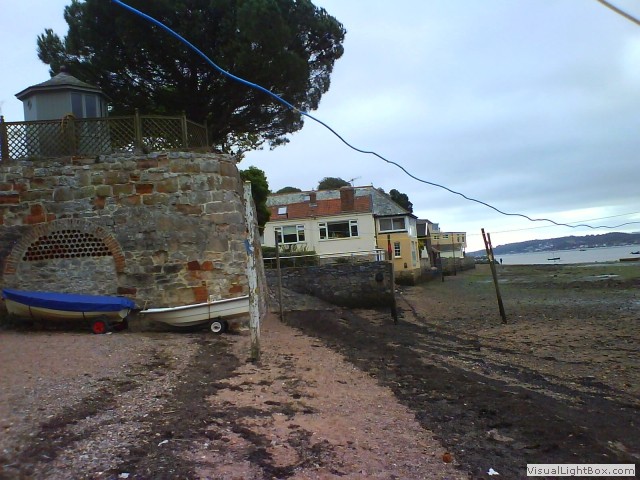 We turn inland and cross the ‘Goosemoor and River Clyst bridge’ to Lympstone Commando railway station,
passing the Royal Marines Commando Training Centre. Established in 1940, it's still
one of the principle UK Royal Marines training bases. We cross over the railway and into the
charming small harbour village of Lympstone where a cluster of old cottages are centred
around a lovely red brick clock tower. Known locally as Peter's Tower, it was constructed
in an Italianate style around 1885 by W.H. Peters as a memorial to his wife. On the rise
out of Lympstone village I snapped a rear spoke, as it wasn’t on the drive side, within
five minutes it had been replaced and we were off to have a peak at Lympstone Manor. It's a Georgian
house turned into a contemporary country house hotel with fantastic grounds including
a vineyard, but it’s a bit pricey for my wallet. After the manor it's a slight backtrack
through Sowden village to ride parallel to the ‘Avocet’ line, never leaving sight of the estuary all the way to Exmouth.
It’s approaching forty years since I was in Exmouth and the memories come flooding back
as we ride through the Imperial recreation ground where there used to be Exmouth cycle speedway
track, a sport we used to do as kids. There’s many grand terraced Victorian town houses
as we ride along the sandy esplanade, all white in colour. Exmouth was renowned as a
destination for the wealthy to recover their health and this area is regarded as the
oldest holiday resort in Devon. High above the promenade is Beacon terrace where our hotel
is situated for the night; 'the Royal Beacon', it boasts of being Exmouth’s most historic hotel.
We turn inland and cross the ‘Goosemoor and River Clyst bridge’ to Lympstone Commando railway station,
passing the Royal Marines Commando Training Centre. Established in 1940, it's still
one of the principle UK Royal Marines training bases. We cross over the railway and into the
charming small harbour village of Lympstone where a cluster of old cottages are centred
around a lovely red brick clock tower. Known locally as Peter's Tower, it was constructed
in an Italianate style around 1885 by W.H. Peters as a memorial to his wife. On the rise
out of Lympstone village I snapped a rear spoke, as it wasn’t on the drive side, within
five minutes it had been replaced and we were off to have a peak at Lympstone Manor. It's a Georgian
house turned into a contemporary country house hotel with fantastic grounds including
a vineyard, but it’s a bit pricey for my wallet. After the manor it's a slight backtrack
through Sowden village to ride parallel to the ‘Avocet’ line, never leaving sight of the estuary all the way to Exmouth.
It’s approaching forty years since I was in Exmouth and the memories come flooding back
as we ride through the Imperial recreation ground where there used to be Exmouth cycle speedway
track, a sport we used to do as kids. There’s many grand terraced Victorian town houses
as we ride along the sandy esplanade, all white in colour. Exmouth was renowned as a
destination for the wealthy to recover their health and this area is regarded as the
oldest holiday resort in Devon. High above the promenade is Beacon terrace where our hotel
is situated for the night; 'the Royal Beacon', it boasts of being Exmouth’s most historic hotel.
We showered and changed and had a walk around Exmouth town, and I have to say what a lovely town this is. I can’t remember a modern day town without boarded up shops with the customary homeless sat in the doorways stinking of piss, and dozens and dozens of charity shops. No, Exmouth has maintained its functionality as a centre for people to shop, eat, and socialise, with original combinations of art deco and Victorian buildings.
Day 2- Exmouth to Dawlish via ferry (8 miles)
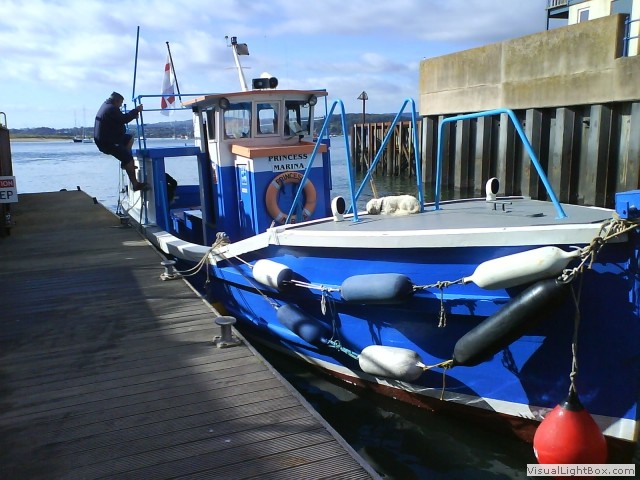 From the hotel are incredible views of the miles of Exmouth beaches and Dawlish Warren spit. After
a full breakfast it’s a short ride back to
the ferry which cost £5 (each) and £1 for the bikes. It's a twenty minute journey to Starcross, and it
was an unprecedented 22°C in October- shorts and short sleeves. When planning
this ride ‘Google maps’ were used, and it showed a café in the middle of the estuary, I thought
this was a mistake, but there is a ‘River Exe Café’ on an old barge right in the middle of the estuary, though
without a boat I've no idea how to get there. Once landed at Starcross we retrace our
route around Cockwood harbour. Through Dawlish Warren which is almost completely made up
of static caravan parks. The name ‘ Warren’ has described this place for centuries and
simply implies it was used to raise rabbits on a commercial basis for meat and fur,
probably since the Middle Ages. The area massively relies on tourism, but it’s
not known how long it will last. The speeding
up of coastal erosion at Dawlish Warren has raised concerns over the future of its
famous beach and nature reserve. The Dawlish Warren sand spit
would have provided a wonderful landing beach in the event of an axis invasion
in WW2. As a small deterrent, this area was covered by
at least eight pillboxes, only two of which remain, and only one is easily accessible on
the edge of the golf course.
From the hotel are incredible views of the miles of Exmouth beaches and Dawlish Warren spit. After
a full breakfast it’s a short ride back to
the ferry which cost £5 (each) and £1 for the bikes. It's a twenty minute journey to Starcross, and it
was an unprecedented 22°C in October- shorts and short sleeves. When planning
this ride ‘Google maps’ were used, and it showed a café in the middle of the estuary, I thought
this was a mistake, but there is a ‘River Exe Café’ on an old barge right in the middle of the estuary, though
without a boat I've no idea how to get there. Once landed at Starcross we retrace our
route around Cockwood harbour. Through Dawlish Warren which is almost completely made up
of static caravan parks. The name ‘ Warren’ has described this place for centuries and
simply implies it was used to raise rabbits on a commercial basis for meat and fur,
probably since the Middle Ages. The area massively relies on tourism, but it’s
not known how long it will last. The speeding
up of coastal erosion at Dawlish Warren has raised concerns over the future of its
famous beach and nature reserve. The Dawlish Warren sand spit
would have provided a wonderful landing beach in the event of an axis invasion
in WW2. As a small deterrent, this area was covered by
at least eight pillboxes, only two of which remain, and only one is easily accessible on
the edge of the golf course.
Rather cheekily we rode back to Dawlish on the SW coastal path crossing the railway to pick up the car at Dawlish station. Again out of the five people on the mile stretch, one had to say, "can’t you read the signs?" We put the bikes away and had a walk around Dawlish (famous for black swans of all things), normality was restored with every other shop occupied by a charity. Still, it was pleasant. This route was predominantly flat, only leaving sea level to visit Powderham Castle and our hotel (which by its nature wouldn’t be any good as a beacon without being on higher ground). The weather was kind on the first day, overcast, but at 17°C it was quite warm, the second day was boiling. Time changes the land and I don’t quite know what I was expecting at the bascule bridges, all that was there to mark a special moment in history was a small plaque on one of the bridges. That said it was an excellent ride with some unexpected railway history and some reminiscing on a sport I left in the eighties. Good ride.
-
Gallery
 Why not have a look at the gallery relating to this ride. Click the image or the title.
Why not have a look at the gallery relating to this ride. Click the image or the title. -
South Devon Atmospheric Railway
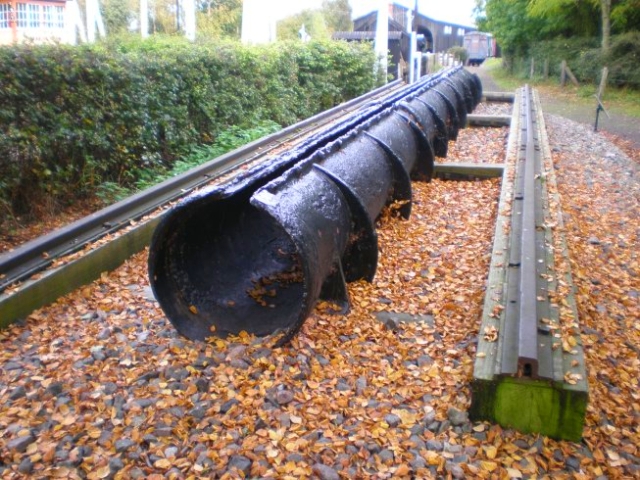 The atmospheric railway system was designed in 1846 by Isambard Kingdom Brunel for the
South Devon Railway Company. It consisted of a semi enclosed tube that ran the length of the
railway, air was sucked out of the tube (creating a vacuum) in the direction you want
the attached engine to run, and pressure was pumped in at the rear. As you can imagine
the design flaw was keeping the seals air tight, but the system did operate for a short
while until economic collapse of the line in 1848. Starcross Yacht Club (reputed to
be one of the oldest sailing clubs in the British Isles) now occupies the site of the old pumphouse.
The atmospheric railway system was designed in 1846 by Isambard Kingdom Brunel for the
South Devon Railway Company. It consisted of a semi enclosed tube that ran the length of the
railway, air was sucked out of the tube (creating a vacuum) in the direction you want
the attached engine to run, and pressure was pumped in at the rear. As you can imagine
the design flaw was keeping the seals air tight, but the system did operate for a short
while until economic collapse of the line in 1848. Starcross Yacht Club (reputed to
be one of the oldest sailing clubs in the British Isles) now occupies the site of the old pumphouse. -
Exeter Blitz
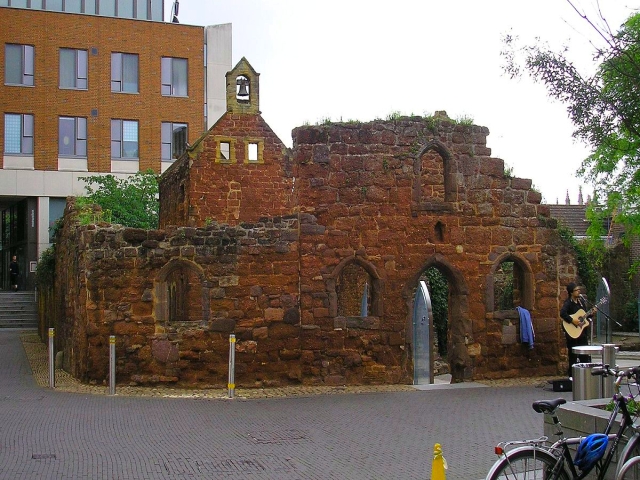 Just after midnight on the 4th May 1942, twenty German bombers arrived over
Exeter, within seventy minutes the town centre was devastated. Incendiary bombs
fell in the High St causing fires in the shops and houses, which were soon out
of control. Under the threat of unexploded ordnance, the local Fire brigade
struggled to tame the inferno. Reinforcements came from Torquay and Plymouth;
eventually 195 appliances were employed to bring the flames under control.
Thirty acres of the City were devastated, and 156 people were killed and many
more injured.
Just after midnight on the 4th May 1942, twenty German bombers arrived over
Exeter, within seventy minutes the town centre was devastated. Incendiary bombs
fell in the High St causing fires in the shops and houses, which were soon out
of control. Under the threat of unexploded ordnance, the local Fire brigade
struggled to tame the inferno. Reinforcements came from Torquay and Plymouth;
eventually 195 appliances were employed to bring the flames under control.
Thirty acres of the City were devastated, and 156 people were killed and many
more injured. -
Countess Wear Paper Mills
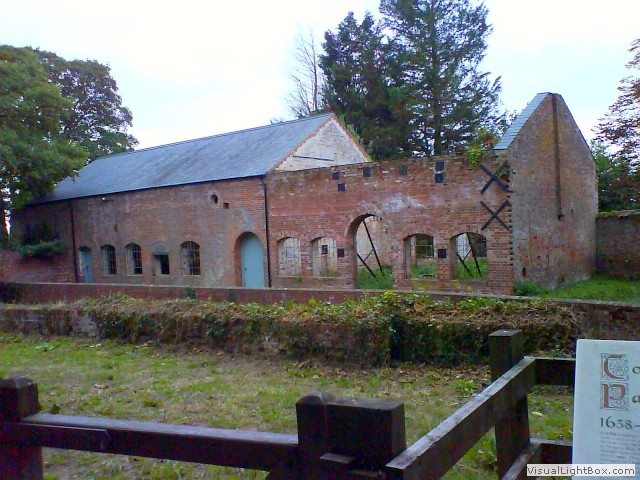 Built on a small island in the river Exe, the mill site could house several wheels, each performing a
different function. In 1757 there were two fulling mills, a leather mill, three grist mills, and one rape seed mill.
The multi-mill nature of the site is confirmed when in 1777, a Higher and Lower mill were
mentioned in the local land registry, this was the first time two paper mills are recorded at Countess Wear.
Built on a small island in the river Exe, the mill site could house several wheels, each performing a
different function. In 1757 there were two fulling mills, a leather mill, three grist mills, and one rape seed mill.
The multi-mill nature of the site is confirmed when in 1777, a Higher and Lower mill were
mentioned in the local land registry, this was the first time two paper mills are recorded at Countess Wear. -
Lymstone
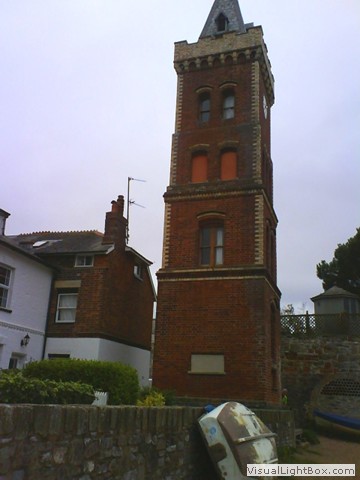 Lymstone has been a fishing village since the Roman times, and is full of narrow streets
with the cottage fronts directly onto the road. The Exe Estuary cycle trail passes right
through the village which has its own small harbour. Peter’s clock tower has one of the
clocks facing out to sea so that the fishermen can gauge the tides properly.
Lymstone has been a fishing village since the Roman times, and is full of narrow streets
with the cottage fronts directly onto the road. The Exe Estuary cycle trail passes right
through the village which has its own small harbour. Peter’s clock tower has one of the
clocks facing out to sea so that the fishermen can gauge the tides properly. -
The Royal Beacon Hotel
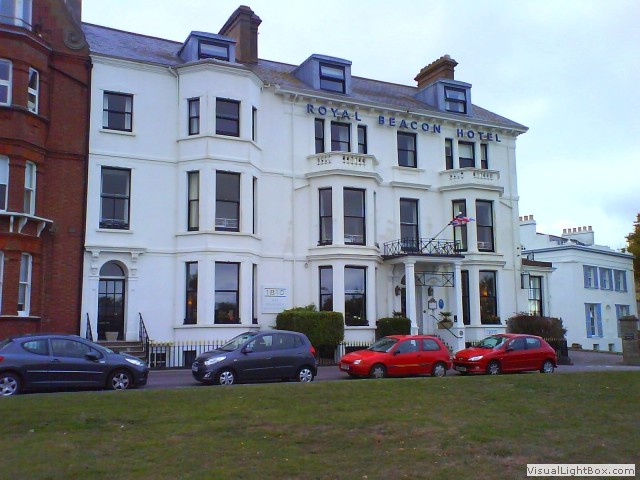 Due to the fear of a Spanish invasion, the whole South coast was connected by a series of
beacons on prominent outcrops and cliff tops. They could be lit on sight of an invading
force, with news travelling from Lands’ end to London in just a few hours. The beacon
keepers in Exmouth were visible to the Beacon Keepers at Berry head in Brixham, as soon
as that was lit, Exmouth would spring into action and relay the message eastwards.
Due to the fear of a Spanish invasion, the whole South coast was connected by a series of
beacons on prominent outcrops and cliff tops. They could be lit on sight of an invading
force, with news travelling from Lands’ end to London in just a few hours. The beacon
keepers in Exmouth were visible to the Beacon Keepers at Berry head in Brixham, as soon
as that was lit, Exmouth would spring into action and relay the message eastwards. -
Brunel Camping Carriages
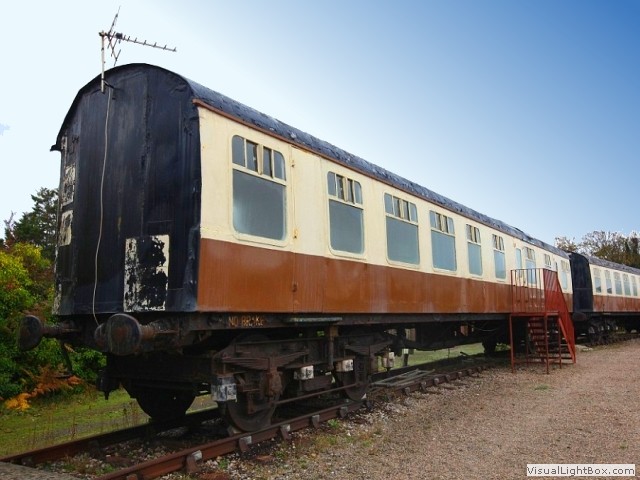 Near Dawlish Warren railway station is an unusual sight of a dozen railway carriages which
in all honesty look derelict. They form part of the Brunel Camping Carriages holiday site
and are currently under restoration after the site was sold in 2016. The coaches have been a
unique tourist attraction in Dawlish Warren since opening and have accommodated hundreds of
families over the past fifty years.
Near Dawlish Warren railway station is an unusual sight of a dozen railway carriages which
in all honesty look derelict. They form part of the Brunel Camping Carriages holiday site
and are currently under restoration after the site was sold in 2016. The coaches have been a
unique tourist attraction in Dawlish Warren since opening and have accommodated hundreds of
families over the past fifty years. -
Dawlish ambush predators
 They say no visit to Dawlish is complete without a walk along the coastal
path, so that’s what we did (riding slower than a mobility scooter). It is obviously fiercely
defended by the locals and even on a day with an infinitesimal sprinkling of people on it, some
natives must sit there all day just waiting for a bike to ride past
(in the animal world they’re called ‘Ambush predators’) so they can make a comment.
They say no visit to Dawlish is complete without a walk along the coastal
path, so that’s what we did (riding slower than a mobility scooter). It is obviously fiercely
defended by the locals and even on a day with an infinitesimal sprinkling of people on it, some
natives must sit there all day just waiting for a bike to ride past
(in the animal world they’re called ‘Ambush predators’) so they can make a comment.

 The atmospheric railway system was designed in 1846 by Isambard Kingdom Brunel for the
South Devon Railway Company. It consisted of a semi enclosed tube that ran the length of the
railway, air was sucked out of the tube (creating a vacuum) in the direction you want
the attached engine to run, and pressure was pumped in at the rear. As you can imagine
the design flaw was keeping the seals air tight, but the system did operate for a short
while until economic collapse of the line in 1848. Starcross Yacht Club (reputed to
be one of the oldest sailing clubs in the British Isles) now occupies the site of the old pumphouse.
The atmospheric railway system was designed in 1846 by Isambard Kingdom Brunel for the
South Devon Railway Company. It consisted of a semi enclosed tube that ran the length of the
railway, air was sucked out of the tube (creating a vacuum) in the direction you want
the attached engine to run, and pressure was pumped in at the rear. As you can imagine
the design flaw was keeping the seals air tight, but the system did operate for a short
while until economic collapse of the line in 1848. Starcross Yacht Club (reputed to
be one of the oldest sailing clubs in the British Isles) now occupies the site of the old pumphouse.  Just after midnight on the 4th May 1942, twenty German bombers arrived over
Exeter, within seventy minutes the town centre was devastated. Incendiary bombs
fell in the High St causing fires in the shops and houses, which were soon out
of control. Under the threat of unexploded ordnance, the local Fire brigade
struggled to tame the inferno. Reinforcements came from Torquay and Plymouth;
eventually 195 appliances were employed to bring the flames under control.
Thirty acres of the City were devastated, and 156 people were killed and many
more injured.
Just after midnight on the 4th May 1942, twenty German bombers arrived over
Exeter, within seventy minutes the town centre was devastated. Incendiary bombs
fell in the High St causing fires in the shops and houses, which were soon out
of control. Under the threat of unexploded ordnance, the local Fire brigade
struggled to tame the inferno. Reinforcements came from Torquay and Plymouth;
eventually 195 appliances were employed to bring the flames under control.
Thirty acres of the City were devastated, and 156 people were killed and many
more injured. Built on a small island in the river Exe, the mill site could house several wheels, each performing a
different function. In 1757 there were two fulling mills, a leather mill, three grist mills, and one rape seed mill.
The multi-mill nature of the site is confirmed when in 1777, a Higher and Lower mill were
mentioned in the local land registry, this was the first time two paper mills are recorded at Countess Wear.
Built on a small island in the river Exe, the mill site could house several wheels, each performing a
different function. In 1757 there were two fulling mills, a leather mill, three grist mills, and one rape seed mill.
The multi-mill nature of the site is confirmed when in 1777, a Higher and Lower mill were
mentioned in the local land registry, this was the first time two paper mills are recorded at Countess Wear.  Lymstone has been a fishing village since the Roman times, and is full of narrow streets
with the cottage fronts directly onto the road. The Exe Estuary cycle trail passes right
through the village which has its own small harbour. Peter’s clock tower has one of the
clocks facing out to sea so that the fishermen can gauge the tides properly.
Lymstone has been a fishing village since the Roman times, and is full of narrow streets
with the cottage fronts directly onto the road. The Exe Estuary cycle trail passes right
through the village which has its own small harbour. Peter’s clock tower has one of the
clocks facing out to sea so that the fishermen can gauge the tides properly.  Due to the fear of a Spanish invasion, the whole South coast was connected by a series of
beacons on prominent outcrops and cliff tops. They could be lit on sight of an invading
force, with news travelling from Lands’ end to London in just a few hours. The beacon
keepers in Exmouth were visible to the Beacon Keepers at Berry head in Brixham, as soon
as that was lit, Exmouth would spring into action and relay the message eastwards.
Due to the fear of a Spanish invasion, the whole South coast was connected by a series of
beacons on prominent outcrops and cliff tops. They could be lit on sight of an invading
force, with news travelling from Lands’ end to London in just a few hours. The beacon
keepers in Exmouth were visible to the Beacon Keepers at Berry head in Brixham, as soon
as that was lit, Exmouth would spring into action and relay the message eastwards. Near Dawlish Warren railway station is an unusual sight of a dozen railway carriages which
in all honesty look derelict. They form part of the Brunel Camping Carriages holiday site
and are currently under restoration after the site was sold in 2016. The coaches have been a
unique tourist attraction in Dawlish Warren since opening and have accommodated hundreds of
families over the past fifty years.
Near Dawlish Warren railway station is an unusual sight of a dozen railway carriages which
in all honesty look derelict. They form part of the Brunel Camping Carriages holiday site
and are currently under restoration after the site was sold in 2016. The coaches have been a
unique tourist attraction in Dawlish Warren since opening and have accommodated hundreds of
families over the past fifty years. They say no visit to Dawlish is complete without a walk along the coastal
path, so that’s what we did (riding slower than a mobility scooter). It is obviously fiercely
defended by the locals and even on a day with an infinitesimal sprinkling of people on it, some
natives must sit there all day just waiting for a bike to ride past
(in the animal world they’re called ‘Ambush predators’) so they can make a comment.
They say no visit to Dawlish is complete without a walk along the coastal
path, so that’s what we did (riding slower than a mobility scooter). It is obviously fiercely
defended by the locals and even on a day with an infinitesimal sprinkling of people on it, some
natives must sit there all day just waiting for a bike to ride past
(in the animal world they’re called ‘Ambush predators’) so they can make a comment.